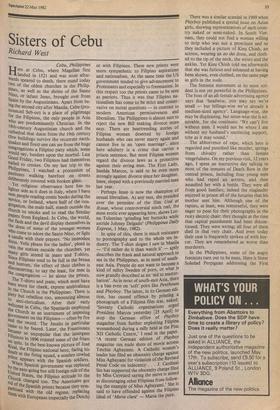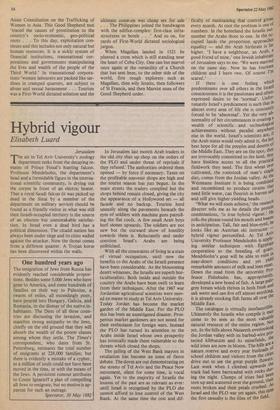Sisters of Cebu
Richard West
Here at Cebu, where Magellan first landed in 1521 and was soon after- wards speared to death, there stand today two of the oldest churches in the Philip- Pines, as well as the shrine of the Santo Nino, or infant Jesus, brought over from Spain by the Augustinians. Apart from be- ing the second city after Manila, Cebu (pro- nounced Seb-oo) is a place of pilgrimage for the Filipinos, the only people in Asia who are predominantly Christian. In the 18th-century Augustinian church and the cathedral that dates from the 19th century (few buildings survive the recurrent earth- quakes and fires) one can see from the huge congregations a Filipino piety which, some would say, borders upon the morbid. Last Good Friday, two Filipinos had themselves nailed to crosses. On my last trip to the Philippines, I watched a procession of Penitents walking barefoot on streets deliberately covered with broken glass. Yet religious observance here has its lighter
side as it does in Italy, where I have seen people reading comic books during the service, or Ireland, where half of the con- gregation, the male half, stands outside the church to smoke and to read the Sunday Papers from England. In Cebu, the world, the flesh and the devil display themselves in the dress of some of the younger women Who come to adore the Santo Nino, or light
a candle with their prayers. 'No immodest dress. Veils please for the ladies', plead in vain the notices outside the churches, yet many girls attend in jeans and T-shirts. Since Filipinas tend to be full in the breast and bottom, the effect of their clothes is disconcerting, to say the least, for men in the congregation — let alone the priests. , The T-shirts and jeans, which must have been worn for cheek, express ambivalence to the Church in the Philippines. There is piety but rebellion too, amounting almost anti-clericalism. After their early the in Cebu, the Spaniards employed Lae Church as an instrument of imposing government on the Filipinos — often by fire and the sword. The Jesuits in particular carne to be feared. Later, the Franciscans F,Fe471, be so unpopular that the insurgent lupines in 1896 roasted some of the friars c?.,11 spits. In the best-known picture of Jose zal, the Filipino national hero, facing his death at the firing squad, a sombre cow led priest appears with the Spanish soldiers. b When Spanish government was replaced the easy-going but still foreign rule of the Church States, the Filipino attitude to the rid of changed too. The Americans got 'u o! the $panish priests because they sym- pathised with the old regime, replacing them with Europeans (especially the Dutch)
or with Filipinos. These new priests were more sympathetic to Filipino aspirations and nationalism. At the same time the US government tended to give advancement to Protestants and especially to freemasons. In this respect too the priests came to be seen as patriots. Thus it was that Filipino na- tionalism has come to be strict and conser- vative on moral questions — in contrast to modern American permissiveness and liberalism. The Philippines is almost sure to reject the new Bill making divorce more easy. There are heartrending stories of Filipina women deserted by foreign husbands who can never marry again and cannot live in an 'open marriage', since here adultery is a crime that carries a prison sentence. But most Filipina women regard the divorce laws as a protection against their erring men. The First Lady, Imelda Marcos, is said to be even more strongly against divorce since her daughter, Imee, eloped with a previously married man last year.
Perhaps Imee is now the champion of sexual liberalism. At any rate, she presided over the premiere of the film Clod at Rosas, whose controversial ninth reel, the most erotic ever appearing here, shows Lor- na Tolentino 'grinding her buttocks while astride Johnny Delgado' (Philippines Daily Express, 1 May, 1982). In spite of this, there is much resistance to pornography and to the whole sex in- dustry. The T-shirt slogan 1 saw in Manila — 'I'd rather do it than watch it' — aptly describes the frank and natural approach to sex in the Philippines, as in most of south- east Asia. People do not want to become a kind of sultry Sweden of porn, or what is now grandly described as an 'aid to mastur- bation'. As in most of south-east Asia, there is a ban even on 'soft' porn like Penthouse and Playboy. The latter, in its German edi- tion, has caused offence by printing a photograph of a Filipina film star, naked: `Seventy Catholic organisations urged President Marcos yesterday [25 April] to stop the German office of Playboy magazine from further exploiting Filipina womanhood during a rally held at the Pius XII Catholic Centre,' I read in the paper. `A recent German edition of Playboy magazine ran nude shots of movie actress Tetchie Agbayami. A Catholic women's leader has filed an obscenity charge against Miss Agbayami for violation of the Revised Penal Code on indecency . . . J. Cardinal Sin has supported the obscenity charge filed by Miss Cayetard saying the move is aimed at discouraging other Filipinas from follow- ing the example of Miss Agbayami.'
She is
said to have offended against the Filipino ideal of 'Maria Clara' — Maria the pure. There was a similar scandal in 1969 when Playboy published a special issue on Asian girls, showing representatives of each coun- try naked or semi-naked. In South Viet- nam, they could not find a woman willing to strip who was not a prostitute and so they included a picture of Kieu Chinh, an actress, wearing an ao dai dress, and cloth- ed to the tip of the neck, the wrists and the ankles. Yet Kieu Chinh told me afterwards that she was furious and ashamed at having been shown, even clothed, on the same page as girls in the nude.
The feminist movement at its most stri- dent is not yet powerful in the Philippines. The boss of an all-female advertising agency says that `headwise, you may say we're small — but billings-wise we're already a medium-sized agency'. Language-wise, she may be displeasing, but sense-wise she is ad- mirable, for she continues: 'We can't live without men. I would not be where I am without my husband's unstinting support, trite as it may sound.'
The abhorrence of rape, which here is regarded and punished like murder, springs from chivalry rather than female vengefulness. On my previous visit, 12 years ago, I spent an instructive day talking to most of the inmates of Death Row in the central prison, including four young men who had raped an actress, and then assaulted her with a bottle. They were all from good families; indeed the ringleader enjoyed in prison all of the luxuries that his mother sent him. Although one of the rapists, at least, was remorseful, they were eager to pose for their photographs in the rusty electric chair: they thought at the time that capital punishment had been discon- tinued. They were wrong; all four of them died in that very chair. And even today their case is frequently spoken of with hor- ror. They are remembered as worse than murderers.
In the Philippines, some of the angry feminists turn out to be nuns. Here is Sister Soledad Perpignan addressing the First Asian Consultation on the Trafficking of Women in Asia. This Good Shepherd nun `traced the causes of prostitution to the country's socio-economic, geo-political roots . . . To this day, exploitation con- tinues and this includes not only natural but human resources. it is a sickly system of financial institutions, transnational cor- porations and governments manipulating the lives and wealth of the people of the Third World.' In transnational corpora- tions 'women labourers are packed like sar- dines in cramped quarters, are subject to abuse and sexual harassment . . . Tourism was a First-World dictated solution and the ultimate come-on was cheap sex for sale . . . The Philippines joined the bandwagon with the edifice-complex: first-class infra- structures or hotels . . .' And so on, for yards of First-World dictated sociological jargon.
When Magellan landed in 1521 he planted a cross which is still standing near the heart of Cebu City. One can but marvel once again at the versatility of a Church that has sent here, to the other side of the world, first rough explorers such as Magellan, then wily Jesuits, then followers of St Francis, and then Marxist nuns of the Good Shepherd order.







































 Previous page
Previous page